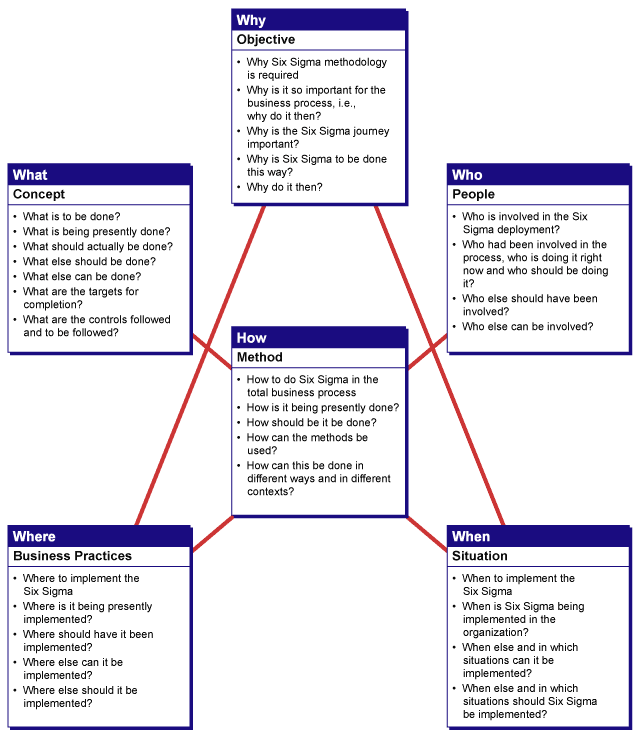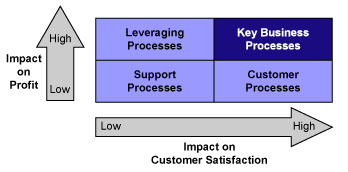
5W1H (who, what, where, when, why, how) is a method of asking questions about a process or a problem taken up for improvement. Four of the W’s (who, what, where, when) and the one H is used to comprehend for details, analyze inferences and judgment to get to the fundamental facts and guide statements to get to the abstraction. The last W (why) is often asked five times so that one can drill down to get to the core of a problem.
5W1H of Six Sigma explains the approach to be followed by exactly understanding and analyzing the process, project or a problem for improvement. Here is an outline of the 5W1H approach for Six Sigma.
What Is Six Sigma –– a Concept
The “what” in Six Sigma is a concept, a subject whose basic goal is to focus on the basic steps and analysis. Six Sigma also is a level of quality applied to variations in any process. Sigma, the Greek letter “σ” is the symbol in statistics used for standard deviation, a measure of variation in the distribution of values. Six Sigma (σ) equates to 3.4 defects per million opportunities, providing a stretch goal of near perfection in business products or services.
In the Six Sigma methodology, anything that dissatisfies the customer is a defect, and so understanding the customer and customer requirements is the most important issue in establishing a Six Sigma culture. Six Sigma is a problem-solving management methodology that can be applied to any type of business process to identify and eliminate the root causes of defects, ultimately improving the key business processes and saving cost for the organization. In this regard, the main goal of Six Sigma is that any quality improvements in an organization need to be economically viable.
Six Sigma, as a management philosophy, allows an organization to apply a disciplined, data-driven approach that continuously brings improvement in business process performance by reducing the variability in each business process. Six Sigma creates a culture in an organization aimed at learning to build processes that delivers the business output with flawless quality. Six Sigma also focuses on measuring and controlling the variation at each stage of business process. That sometimes creates a mistaken notion that Six Sigma is a set of statistical tools and a mere strategy for their use. The reality is Six Sigma is a blending of the wisdom of an organization with a methodology and an extensive toolkit to improve both the efficiency and effectiveness of the organization in meeting its the customer requirements.
Why Six Sigma –– an Objective
How to achieve the goals is accomplished in “why” context. The goal of Six Sigma is to help people in their attempt to improve business processes to deliver defect-free products and services. Six Sigma requires practitioners to consider both the “voice of the customer” and the “voice of the process,” it reduces the gap between the two voices. That leads to more satisfied customers, and that is what makes the Six Sigma initiative a profitable business proposition. Not only does the Six Sigma organization save costs, but it also has great opportunity to increase sales.
Six Sigma focuses on long and sustained success for every improvement projects, improving each and every process in the organization. That gives organizations a way to continue improving year after year and even provides a system that rewards “out of the box” thinking, which can accelerate the rate of improvement.
Since it is a data-driven approach to problem solving, Six Sigma builds robustness in daily management. This starts a set of chain reaction in strategic, tactical and operational improvements, which compels the organization to set a stretch target for every business performance and set goals for everyone in the organization.

Who Is Involved in Six Sigma –– People Involvement
Six Sigma eventually involves every one in the organization, starting from the top management to the operator/staff level. It requires a companywide understanding of the processes, a commitment toward achieving the set goals and an involvement in projects that accompany those goals. Since Six Sigma is for the total business process, it involves everyone in the organization.
The top levels of management appoint Sponsors, who are members of the leadership team who are responsible for selecting Six Sigma projects and are ultimately accountable for project results. Just under the Sponsors are Champions, who typically have day-to-day responsibility for the business process being improved and their role is to ensure the Six Sigma project team has the resources required to successfully execute the project. Next are the Master Black Belts, who teach and mentor the Black Belts, who have been trained to manage Six Sigma projects and serve as leaders of project teams consisting of Green Belts and other employees. Green Belts are core project team members, and even serve as team leaders on smaller projects. And the other members of project teams are regular employees.
In well-functioning Six Sigma deployments, everyone in the organization is involved in reducing defects, reducing cycle times and increasing customer satisfaction.
Where to Apply Six Sigma –– Business Process Location
Six Sigma is applied to all business processes. To start with, it can be applied to key business processes which have the highest visible impact on the customers and shareholders. All business processes impacting customer satisfaction and profit growth of the organization need to undergo Six Sigma methodology implementation.

When to Apply Six Sigma
As long as an organization has a strong desire to improve the business performance by identifying each and every key business processes for improvement, the starting point of Six Sigma does not matter. Organizations can implement Six Sigma:
- When they find out that the customer satisfaction level is eroding.
- When they want to retain a leadership position through quality in the market.
- When there is a clear indication of losing market share due to quality.
- When their processes have not changed for a long time.
- When the quality of a product is largely dependent on human inspection skills instead of being built-in to the production process.
- When they think their processes have all reached an improvement plateau.
- When they are required to improve performance in all areas of their business process.
- When they decide they want to survive and grow in today’s competitive market.
How to Apply Six Sigma –– Methodology Followed
Depending upon the requirement of the organization and the type of organization different strategies are followed for Six Sigma implementation.
The three main strategies followed in Six Sigma are:
- Process Management: An ongoing cross-functional ownership and measurement of core support processes.
- Process Improvement: Focused on problem solving, aimed at eliminating the vital few root causes. It is most common to use the DMAIC roadmap:
- Define – Select customer’s critical-to-quality characteristics (CTQs). Define the process improvement goals that are consistent with customer demands and enterprise strategy.
- Measure – Create a measurement system and validate the system. Measure the current process and collect relevant data for future comparison.
- Analyze – Identify the sources of variation from the performance objectives. Analyze to verify relationship and causality of factors. Determine what the relationship is and attempt to ensure that all factors have been considered using one or more of the tools in the Six Sigma toolkit.
- Improve – Discover process relationships and establish new and improved procedures. Improve or optimize the process based upon the analysis.
- Control – Sustain the gain by implementing process controls. Control to ensure that any variances are corrected before they result in defects. Set up pilot runs to establish process capability, transition to production and thereafter continuously measure the process and institute control mechanisms.
- Process Design/Redesign: The creation of a new process to achieve exponential improvement and/or meet the changing demands of customers, technology and competition. It must handle totally dysfunctional processes and reengineer them. It is also known as Design for Six Sigma (DFSS). DMADV is the most common roadmap followed for DFSS:
- Define – Define the goals of the design activity that are consistent with customer demands and enterprise strategy.
- Measure – Measure and identify CTQs, product capabilities, production process capability and risk assessments.
- Analyze – Analyze to develop and design alternatives, create high-level design and evaluate design capability to select the best design.
- Design – Design details, optimize the design, and plan for design verification. This phase may require simulations.
- Verify – Verify the design, set up pilot runs, implement production process and handover to process owners.
The structure of 5W1H of Six Sigma can help organizations to consider all aspects of the Six Sigma situation in detail and hence can be implemented when analyzing a business process for improvement opportunities. The interrelationships also guide Six Sigma practitioners to take systematic error-free steps to complete the Six Sigma project successfully on-time and every-time.